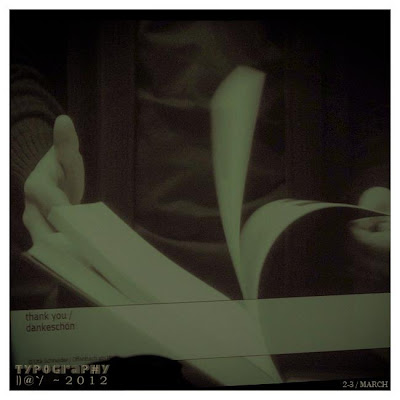The 5th Edition of Typography Day 2012, held at IIT Powai was about Typography in Publication Design.
 Installations at TypoDay2012 with mastheads of newspapers
Installations at TypoDay2012 with mastheads of newspapers
The interesting part of the 2 day seminar was the variety in the cultural exposure of our country versus other countries. Being so culturally rich; the potential is still being minimally explored. But our typography is still not catching up in the same sphere unlike other countries, which it needs to. Some brilliant speakers blew the stage away.
Amongst them was keynote speaker, Ken Botnick . He spoke about ‘Age’, as not just a number but rather, impressed on how ones vision reduces with age. He posed a question, ‘How can we, as typographers, address the problem?’ and ‘Does everyone sees things the way you do?’
The other keynote Speaker, Bishwadeep Moitra spoke about ‘Dressing up a Dog’s Dinner.’ As the title suggests, he spoke about how a weekly news magazine can be made to look pretty alongside serious content. He also opined on the concept of change being unreasonable to the public and how Outlook overcame it over a period of time while being sent death threat mails from their loyal customers.
Amongst the international speakers, Rathna Ramanathan from Central Saint Martins School of Art & Design, London is worth a mention. She showed us how expressive typography in books makes for interesting reading for kids.
Denielle Emans, from Zayed University, Dubai spoke about preserving the Mayan Language. Her work includes promoting the language to children living in the Yucatan Peninsula, using story books, which is a great initiative to preserve the language.
Uta Schneider, from Stiftung Buchkunst, Germany spoke about Book Design. She said that it was the showcase field in visual communication and elaborated on how the design of every book reflects the content inside.
Mahmood Mazaheri Tari, from Tehran, Iran spoke about the unending abilities Of Persian Typefaces & how the Stencil for Persian Calligraphy works and was created by taking inspiration from stencils of the English medium.
Pallavi Sudhanshu Apte, an ex student of J.J School of Arts spoke about multilingual ambigrams & her work in the field.
Santosh Kshirsagar, PhD Researcher, Industrial Design Centre, IIT Bombay spoke about Handwriting Practice Manuals in today’s day & age and how typographers should build a form and shape to teach children about the study of character per alphabet.
Kimya Gandhi, Alumnus, IDC, IIT Bombay did a typeface design at Linotype during her internship. It was the Devanagiri version of the English Typeface Din.
Sandeep Bomble, from Palasha Creative House being the final speaker blew the audience away with his powerful presentation based on Typography in Communication Medium which is about the visual expression and form.
Alongside the outstanding speakers, there were also some disappointing speakers, primarily due to the fact that the quality of work was not in the same league.
Nevertheless, there were some interesting installations alongside typographic work of students and banners of typographic experiments done by various people of their favourite word in their mother tongue.
 Experimental Typography Banners
Experimental Typography Banners
Last but not the least, the lifetime achievement award for typography was given to Mukund Gokhale. What can one say about him? The less said the better. A standing ovation, shawl, plaque, flowers apart, the man himself is a book of overflowing knowledge & experiments. As an Indian designer, one should be proud to have seen his era of work.
 Lifetime Achievement Award to Mukund Gokhale given by Sudarshan Dheer
Lifetime Achievement Award to Mukund Gokhale given by Sudarshan Dheer
It was refreshing to meet & network with some quality designers over chai. We were enthralled to find out that they believe in giving our vernacular language fonts a push by designing a variety that can be used in print & in digital both which is exciting to us, rather than aping the western culture. And a lot of students seem to be weaning in this direction which means in the coming years there is going to be an upsurge given to the written word. That will give a boost to the importance of literacy, we sincerely hope J
Now we’re back, inspired and how! Now it’s time to put some of these into practical use as this will help put India into the enthralling map of powerful design countries.











